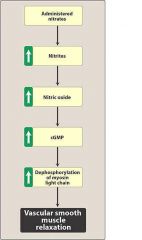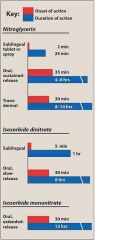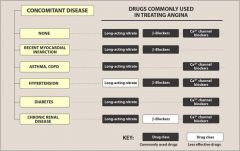![]()
![]()
![]()
Use LEFT and RIGHT arrow keys to navigate between flashcards;
Use UP and DOWN arrow keys to flip the card;
H to show hint;
A reads text to speech;
11 Cards in this Set
- Front
- Back
|
Calcium Channel Blockers
|

Amlodipine (dihydropyridine)
Verapamil (non-dihydropyridine) Decrease inward current carried by calcium, slow conduction and prolong refractory period, decrease heart rate |
|
|
Verapamil (non-dihydropyridine)
|

Calcium channel blocker
Specific to the heart |
|
|
Amlodipine (dihydropyridine)
|

Calcium channel blocker
Specific to vascular smooth muscle |
|
|
Nitrates
|

Large vein dilation = blood pools in veins = decreased preload
Coronary dilation = increased blood supply to heart muscle best for prompt relief of an ongoing attack of angina |
|
|
Nitroglycerin
|

Vasodilation; easy development of tolerance; need daily breaks to avoid tolerance
|
|
|
Isosorbide Mononitrate
|

Vasodilation
Longer acting and used orally |
|
|
Propranolol
|
Beta adrenergic antagonist; not cardioselective
Contraindicated in pts with asthma, diabetes, severe bradycardia, peripheral vascular disease or chronic obstructive pulmonary disease |
|
|
Asprin
|
Inhibits the production of thromboxane that binds platelets together; diminish platelet adhesion, use in low dosage
|
|
|
Morphine
|
analgesics; vasodilating properties and decreases pain
|
|
|
Tenecteplase
|
tissue plasminogen activator cuts up clot; decrease blood cotting
use only after 6 hours of MI; avoid using with high bp due to increase chance of bleeding |
|

|
Drugs commonly used in tx angina
|

